Asus ZenFone 2 – A Zen Master Stroke
Asus ZenFone 2 is the successor for the much successful Asus ZenFone first generation line up of smartphones from Asus. Asus ZenFone 2 is also the first smartphone with a 4GB of RAM. It is now a trend setter and has become a wakeup call for the rest of the smartphone manufacturers. The first generation ZenFone was named by its display size, but the ZenFone 2 has taken a different path. The ZenFone 2 is available in 6 variants in India. Broadly the ZenFone 2 is available in 2 categories with 3 models under each category. The 1.8 GHz had 3 variants and the 2.3 GHz has 3 variants. Other than the processor, RAM and storage capacity, there is not an iota of difference in the rest of the specifications or the design or the dimensions or even the weight, between the 6 variants of ZenFone 2.
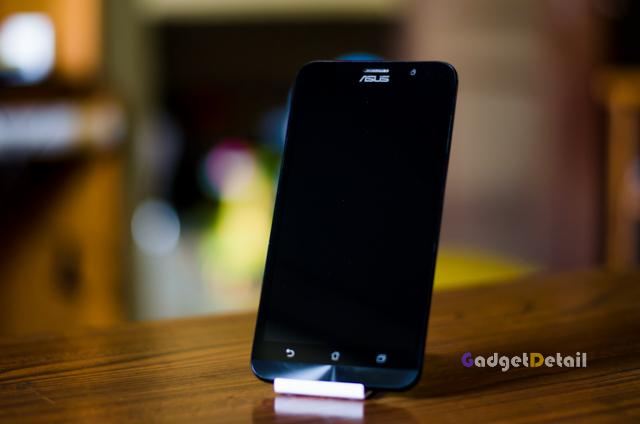
| ZenFone 2 Speficications | ||||||
| Model Number | ZE550ML-1B077WW | ZE551ML-6J329WW | ZE551ML-6J226WW | ZE551ML-6J333WW | ZE551ML-6J337WW | ZE551ML-6JWW |
| Processor | 1.8 GHz Intel Atom Z3560, Quad Core | 1.8 GHz Intel Atom Z3560, Quad Core | 1.8 GHz Intel Atom Z3560, Quad Core | 2.3 GHz Intel Atom Z3580, Quad Core | 2.3 GHz Intel Atom Z3580, Quad Core | 2.3 GHz Intel Atom Z3580, Quad Core |
| RAM | 2 GB | 2 GB | 4 GB | 4 GB | 4 GB | 4 GB |
| Storage | 16 GB | 16 GB | 32 GB | 32 GB | 64 GB | 128 GB |
| Charger | 7W Adapter | 7W Adapter | 7W Adapter | 18W Boost Master Adapter | 18W Boost Master Adapter | 18W Boost Master Adapter |
| Dimensions | 152.5 x 77.2 x 10.9 mm | |||||
| Weight | 170 grams | |||||
| Screen size | 5.5 inch | |||||
| Display resolution | 1080 x 1920 (403 ppi) | |||||
| Operating System | Android 5.0 with Zen UI 2.0 | |||||
| GPU | PowerVR G6430 | |||||
| Primary camera | 13 MP with Dual Tone LED flash | |||||
| Front facing camera | 5 MP camera | |||||
| Battery | 3000 mAh | |||||
| Price | Rs 12999 | Rs 14999 | Rs 18999 | Rs 19999 | Rs 22999 | Rs 29999 |
| Link to Buy | Link to Buy | Link to Buy | Link to Buy | Link to Buy | Link to Buy | |
As a review unit I have the ZE551ML-6J333WW which has a 2.3 GHz Intel Atom Z3580, Quad Core processor and a 4 GB RAM. It has an internal storage of 32 GB and comes with an 18W Boost Master charger adapter.
Design
The design is definitely a head turner. At first glance, the ZenFone 2 in this review may look like device with metal body. But it is a device with plastic body and a brushed metal finish. There are other color variants with different finish, like the matte black version, but it is not available in India as of now. Though I would have loved, if the ZenFone had come with an all metallic premium version, the plastic metal finish has its own charm. The material used is of premium quality and the back cover fits sturdily with the device. When removed it reveals the micro SD card slot, dual micro SIM card slots and a non-removable 3000 mAh battery. At the back of the device is the 13 MP camera with a dual tone LED flash. Below the lens is the volume buttons. I would have loved to see the power button also integrated with the volume buttons at the back, but in the ZenFone 2, the power button is placed at the top, making it very inconvenient to reach. The placement of volume buttons at the back is something you will get used to and once you are used to it, you would want it that way in all the mobiles. However that is not the story with the power button. The power button has feeble tactile response and you need a large hand to handle it with ease. Anyway the ZenFone 2 has tap to wake and tap to sleep function (which drains the battery faster) and make the power button redundant most of the time. The curved back is convenient and ergonomic to hold but when the device is operated while placed on a flat surface, it shakes and wobbles. Yet, the build quality and the design make me conclude that it is a sturdy device, with a stylish finish to it.
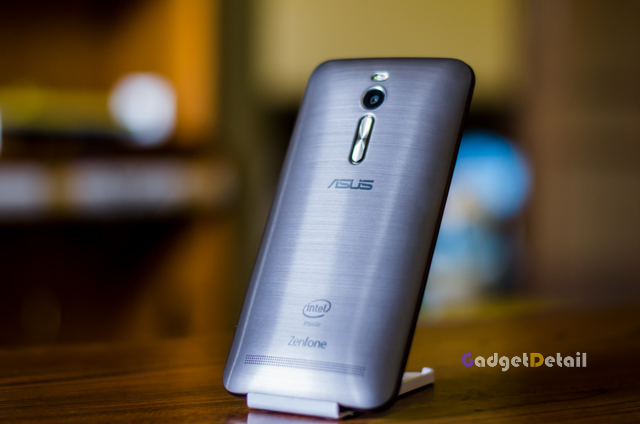
Display
The ZenFone 2 has a 5.5 inch IPD LCD display. It supports a resolution of 1920 x 1080. The screen produces decent black levels and brightness levels. Outdoor legibility was good, but under direct sunlight, the readability of the device is just average. Under normal conditions, the color reproduction is vibrant and the display has decent viewing angles. It is not among the list of brilliant displays we have seen this year, but it definitely a better display among the devices in this price range.
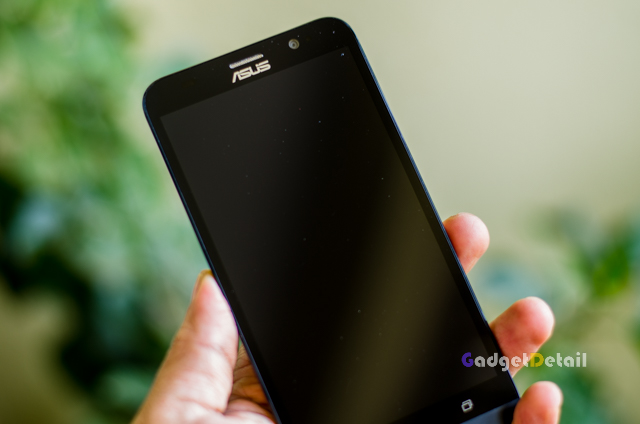
Performance
The ZenFone 2 comes in 2 basic variants: 3 variants with Intel Atom Moorefield Z3560 1.8 GHz processor and 3 variants with Intel Atom Moorefield Z3580 2.3 GHz. All the variants come with PowerVR G6430 for the graphic processing. This is one of the fastest processor I have seen in this segment. It matches Snapdragon 801 in most scenarios and even manages to outperform it under certain circumstances. The graphic performance is above average. It handles intense gaming with ease and shows no signs of stuttering or frame lag. In certain 3D games, the rendering is not smooth and the edges are jagged. But that’s just me nitpicking and the jagged edges are prominent only in resource hogging games. Even under such conditions the processor handles throttling gracefully and the actual gaming experience is pretty smooth. ZenFone 2 handles the OS and the UI on top of it efficiently. So at the end of the day, the ZenFone 2 does not disappoint in performance thanks to Intel’s Atom Moorefield SoC and the massive 4 GB RAM that can hold a ginormous amount of data.
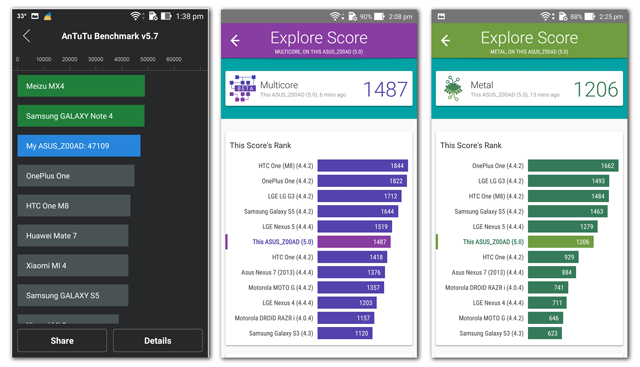
Camera
The ZenFone 2 has a 13 MP rear camera and a 5 MP front facing camera. The 13 MP camera’s sensor is made by Toshiba and the 5 MP by Omnivision. The rear camera lacks optical image stabilization, which would have been a welcome feature. Both the lenses have a wide aperture and are good performers under any lighting conditions. But what good is the hardware, if the software doesn’t compliment it. Fortunately the ZenFone 2 has a sensible Camera application which is both simple and powerful. In the auto mode, the UI controls are simple. Though there are different preset modes, the HDR and Low light mode are automatically suggested based on the light conditions. The gear button reveals the menu for both camera and video. The Manual mode is becoming a standard these days in most mobiles. We saw manual controls for the first time in the Lumia 1020 mobile and since then Manual mode has slowly made its way into other mobiles. In the ZenFone 2 the manual mode can control the White balance, Exposure compensation, ISO, shutter speed and focus. In the UI, the color temperature indication is wrong in the white balance chooser. The warm range is indicated by blue and the cold is indicated by yellow. It must be the reverse. Hope Asus notices this and makes the change.
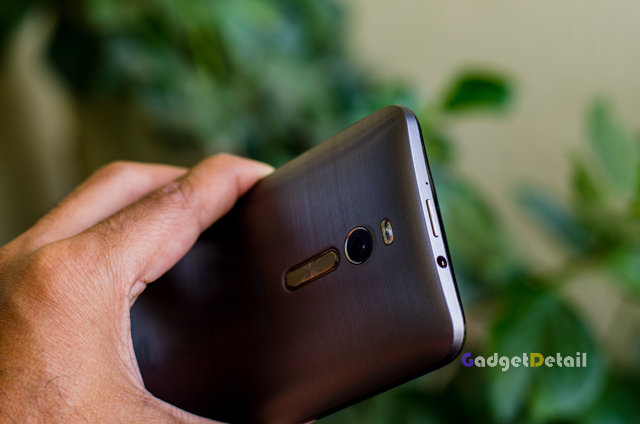
As for the image quality, under normal or well light conditions the images seems to be good. But on closer inspection you would notice that the Pixel master algorithm smoothens the edges in the name of sharpening and reducing noise. Ideally the algorithm must kick in only for low light conditions. Under low light conditions, the ZenFone 2 performs really well. It produces good details and usable images even under extremely low light conditions. In total, the ZenFone 2 has a camera that impresses and also the macro shots and shots with depth of focus are truly amazing. Additionally the ZenFone 2 UI offers loads of preset mode that are fun to use, but not of great utility value.
Check out the camera samples here
Software and UI
The ZenFone 2 runs on Android 5.0 out of the box with the Zen UI on the top. The Zen UI has a long list of pre-installed applications. Most of these apps have better alternatives in the Google Play store and these apps cannot be uninstalled. So I would call them bloat ware sitting on the mobile and eating the space. I like the Zen Mini movies and SuperNote apps out of all these bloat wares. Asus has also tried to reinvent the Notifications UI. But this has already been done by the Native android lollipop and I don’t see a pressing need to redesign it. When the Native android experience is really good these days, I don’t see a need to force fit a skin on top of it. Do you need an app and an icon for a function like torch light, or permission manager or auto start manager? Asus must really have gone the Motorola way, which gives “Close to pure android” experience with a few custom apps preinstalled. Zen UI has very little customization possibilities. But overall the UI is fast and snappy. It does not lag and definitely smoother than the likes of Touch Wiz or SenseUI. In total, the Zen UI is a mixed bag.
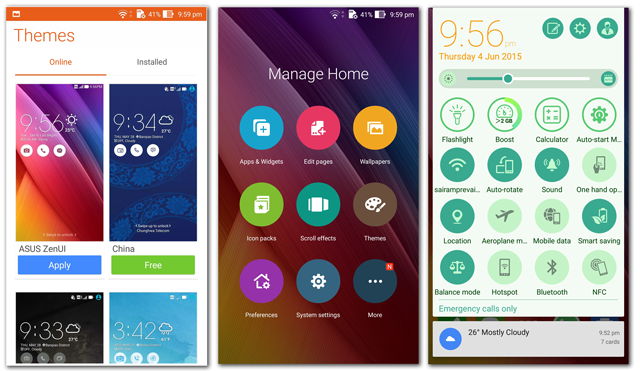
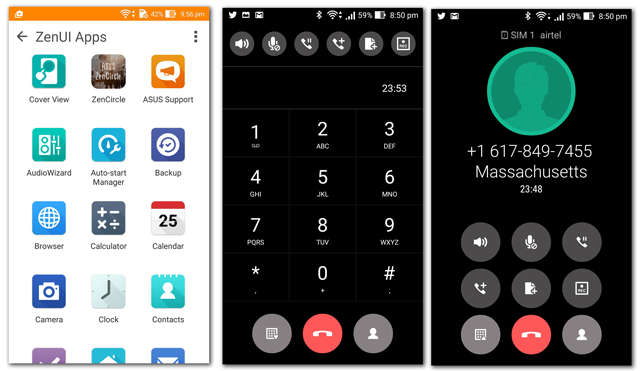
Telephony
Whatever said and done, at the end of the day, the ZenFone 2 is a communication device. Telephony call quality on the ZenFone 2 is just ok. I did have some network issues but that could mostly be an issue with the service provider, though I never faced any such issue with my other mobiles in that area. Calls on speaker was pathetic. Not just the speaker quality, but the mic also is weak. The person at the other end could barely hear me and speaker calls are very important to me as I take long conference calls.
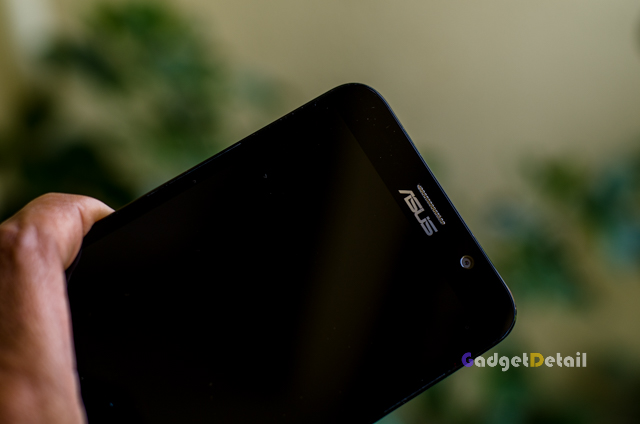
Battery is another department where the ZenFone 2 disappoints. The 4 GB RAM is both a boon and a bane. It is boon for faster interaction and efficient multitasking, but it’s a bane for battery. The ZenFone 2 has a 3000 mAh battery, but because of the 4 GB RAM, Android seldom kills any app in the background. I pushed Asphalt and Nova game to the background and it stayed there for 2 days until I manually closed it. So apps keep running in the background, unless you intervene and close it manually and this drains the battery. Features like tap to wake and sleep also consume power and there is no dedicated core to deal with such listener operations like in the Moto X. With 4G LTE network on, the device lasted for less than a day on normal usage. If I keep waking the display to check WhatsApp or Facebook and click lots of photos, the battery drains quicker than 10 hours. The in-built power saver feature is useless, but the Boost master charger comes to your rescue. It can charge 40% of the device in less than 60 minutes. That can be rephrased as 0-40 in 60 minutes. I wish all the variants of the ZenFone 2 come with a Boostmaster charger. They don’t, though they have the ability. Only the top 3 variants come with it.
Verdict
Finally, having said all that, Should you buy the ZenFone 2 or not? The question can be answered depending on the variant you are interested. Asus has cleverly named all the variants as ZenFone 2. It is like buying a car or a PC. The make and the model name are same, but you get different variants at various price points. While the top variants of the ZenFone 2 are fighting with the flagship devices, the lower variants (ZE550ML-1B077WW and ZE551ML-6J329WW) are priced very competitively. They have almost all the specs of their high end brothers. A full HD display, 3000 mAh batter, 13 MP camera all for Rs 12999 or Rs 14999. Now that is a deal.
What fails to impress me is the over loaded bloatware and poor battery life. If you look at the top variants of ZenFone 2, I cannot stop myself from comparing it with OnePlus One or Samsung S5 or even the MI4. Though these rivals draw first blood, I must appreciate Asus for a bold move with great design, incredible hardware spec and a smooth software experience all for a competitive price. I would give a solid thumbs up for Asus ZenFone 2 and while choosing a variant, be sure of what you want and what you are ready to let go.

[…] Zenfone 2 Laser 6! Yes, it’s yet another Zenfone 2. I tried hard to keep up with all the Zenfone 2 models, but I gave up. It’s really confusing. […]